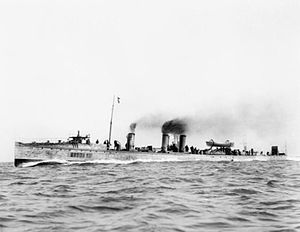Conflict-class destroyer
This article includes a list of general references, but it lacks sufficient corresponding inline citations. (January 2013) |
 HMS Conflict
| |
| Class overview | |
|---|---|
| Name | Conflict class |
| Builders | J. Samuel White, East Cowes, Isle of Wight |
| Operators | |
| Preceded by | Fervent class |
| Succeeded by | Handy class |
| In commission | 1895–1920 |
| Completed | 3 |
| Retired | 3 |
| General characteristics | |
| Type | Destroyer |
| Displacement | 320 long tons (325 t) |
| Length | 200 ft (61 m) |
| Propulsion | White-Forster boilers, 4,500 hp (3,356 kW) |
| Speed | 27 knots (50 km/h; 31 mph) |
| Complement | 53 officers and men |
| Armament | |
Three Conflict-class destroyers served with the Royal Navy. All were built by the White Shipyard.
Under the 1893–1894 Naval Estimates, the British Admiralty placed orders for 36 torpedo-boat destroyers, all to be capable of 27 knots (50 km/h; 31 mph), the "27-knotters", as a follow-on to the six prototype "26-knotters" ordered in the previous 1892–1893 Estimates. As was typical for torpedo craft at the time, the Admiralty left detailed design to the builders, laying down only broad requirements.[1][2]
Conflict, Teazer, and Wizard were 200 feet (61 m) long, displaced 320 tons and produced 4,500 hp (3,400 kW) from their White-Forster boilers to give them a top speed of 27 knots (50 km/h; 31 mph). They were armed, as was standard with ships of this type at the time, with one twelve pounder gun, two torpedo tubes and had a complement of 53 officers and men.
In September 1913 the Admiralty re-classed all the surviving 27-knotter destroyers, including Conflict and Wizard (Teazer having been sold for scrap in 1912) as A Class destroyers.
See also[edit]
Bibliography[edit]
- Chesneau, Roger & Kolesnik, Eugene M., eds. (1979). Conway's All The World's Fighting Ships 1860–1905. London: Conway Maritime Press. ISBN 0-85177-133-5.
- Colledge, J. J.; Warlow, Ben (2006) [1969]. Ships of the Royal Navy: The Complete Record of all Fighting Ships of the Royal Navy (Rev. ed.). London: Chatham Publishing. ISBN 978-1-86176-281-8.
- Friedman, Norman (2009). British Destroyers: From Earliest Days to the Second World War. Barnsley, UK: Seaforth Publishing. ISBN 978-1-84832-049-9.
- Gardiner, Robert & Gray, Randal, eds. (1985). Conway's All The World's Fighting Ships 1906–1921. London: Conway Maritime Press. ISBN 0-85177-245-5.
- Lyon, David (2001) [1996]. The First Destroyers. London: Caxton Editions. ISBN 1-84067-364-8.
- Manning, T. D. (1961). The British Destroyer. Putnam & Co. OCLC 6470051.
- March, Edgar J. (1966). British Destroyers: A History of Development, 1892–1953; Drawn by Admiralty Permission From Official Records & Returns, Ships' Covers & Building Plans. London: Seeley Service. OCLC 164893555.
References[edit]
